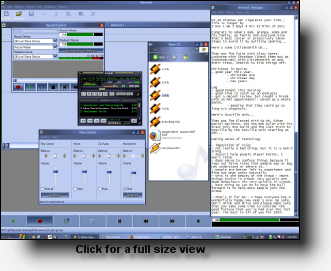I’m still in the process of getting my kit together, but I thought it would still be interesting to give you a glimpse of what my podcast setup looks like from a software perspective. Once I get the rest of the hardware in place – I’m waiting for a microphone, two shock mounts and two mic stands to show up from an order that I made a few weeks back and I’m still looking for a mixing board – I’ll share the rest of the picture.
 My software setup is very simple. Everything I’ve been doing for the last six or seven shows or
so has been done realtime. This means that I’m actually playing music,
talking and recording everything as it happens – a 40 minute show will
take me 40 minutes to record. The only post-production I’ve had to do
actually occurred with the last two holiday shows I’ve done. For the
first one, I shortened down the length of the one-sided conversation
that I had with Paul and stitched in the call music that you heard. For
the second one, I trimmed off the last 5 seconds of dead air because of
the excessive ambient noise. Took me all of 3 minutes to do both edits
combined
My software setup is very simple. Everything I’ve been doing for the last six or seven shows or
so has been done realtime. This means that I’m actually playing music,
talking and recording everything as it happens – a 40 minute show will
take me 40 minutes to record. The only post-production I’ve had to do
actually occurred with the last two holiday shows I’ve done. For the
first one, I shortened down the length of the one-sided conversation
that I had with Paul and stitched in the call music that you heard. For
the second one, I trimmed off the last 5 seconds of dead air because of
the excessive ambient noise. Took me all of 3 minutes to do both edits
combined  . Anyways,
my point is that my shows are largely heard as they get recorded. I
stopped doing multiple takes, editing out the umm’s and ahh’s and other
mistakes that regularly happen.
. Anyways,
my point is that my shows are largely heard as they get recorded. I
stopped doing multiple takes, editing out the umm’s and ahh’s and other
mistakes that regularly happen.
I use Wavepad to do the recording, WinAmp to play the various clips and tunes that you hear throughout the show and Windows Mixer to regulate the levels and turn my mic on and off. An external hardware mixing board will replace the Windows Mixer as soon as I can find something in the right price bracket. I opted for Wavepad over Audacity for reliability reasons. I used Audacity for all of two seconds and was quickly looking for a replacement because of its tendency to crash. I’m currently using the free version of Wavepad.
The show is triggered by the various short cuts and clips that you see in the folder in roughly the middle of the screen. Each of the playlists contains the set of tunes that I want to play, or the opening or closing tracks that I play with each show. I also include Mozilla short cuts in there in case I want to talk about something I found on the web. This keeps everything in one handy place so that I don’t have to do too much thinking while I’m talking.
Winamp has the capability of using plugins which alter how it outputs audio and changes other behaviors. I use a “cross-fader” plugin that creates a seamless transition between the various music tracks that I play on the podcast. It approximates how music is played on broadcast radio in an automated fashion with very pleasing results (and no effort from me).
Everything gets recorded out into Wavepad which captures the raw audio which I initially save as a WAV file and then quickly convert into an MP3. The only reason I save to a WAV first is because it is a relatively quick save and moves the file out of memory onto disk. This takes the pressure off during the relatively long period it takes to encode the MP3 file – if the rig crashes, then I can quickly recover from disk. This is more of a precaution than anything else – the entire combination of software is very stable and I’ve not had any on-air problems that I haven’t caused myself.
Lastly, I use Skype for recording my remote interviews. I’ve experimented with a number of different setups and find the quality, simplicity and value to be unmatched.
On location recordings are done slightly differently. For these, I’ll actually record the show in segments and then stitch in music in post-production. I only have a half-duplex sound card in my laptop which makes it impossible to run a show through in realtime.
On the right-hand side of the screen is a long, thin notepad window. These are my show notes which is really a weird hybrid between a show script and show notes. I find that using a bit of a script helps me get the juices going at the beginning of the various segments and for introducing the music that I play. For the longer segments, I tend to ad lib extensively and rely on the notes strictly as a guideline. I expect that as I grow more practiced that my scripts will become more pointed and less scripty.
If you have any questions about how I fit all this together, make sure that you leave me your questions in my comments section – I’d be more than happy to clarify as much as you want me to!
ps – this screenshot goes with this show. If you look closely, you’ll see that the screen cap was made precisely 34:42.50 minutes into the podcast. 



